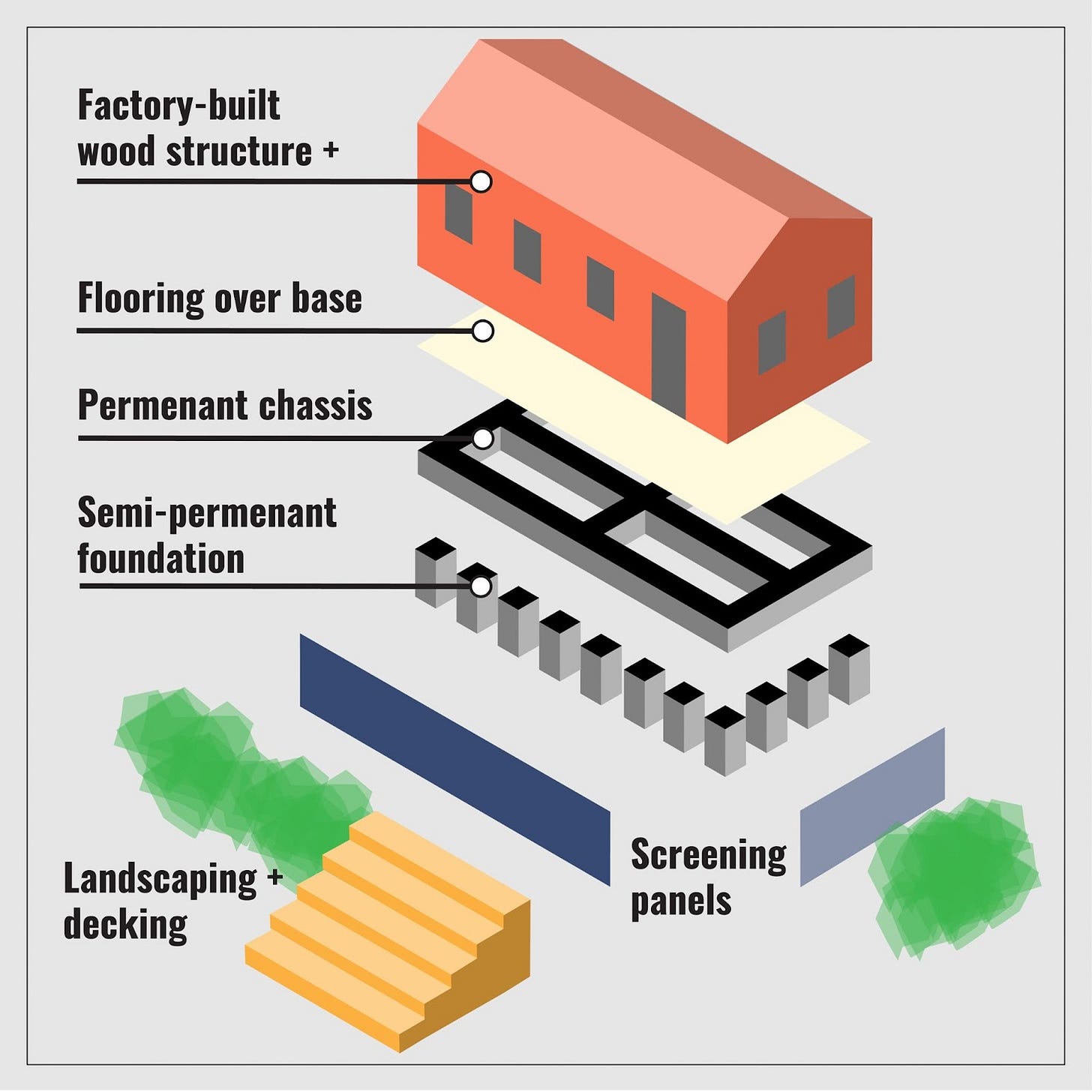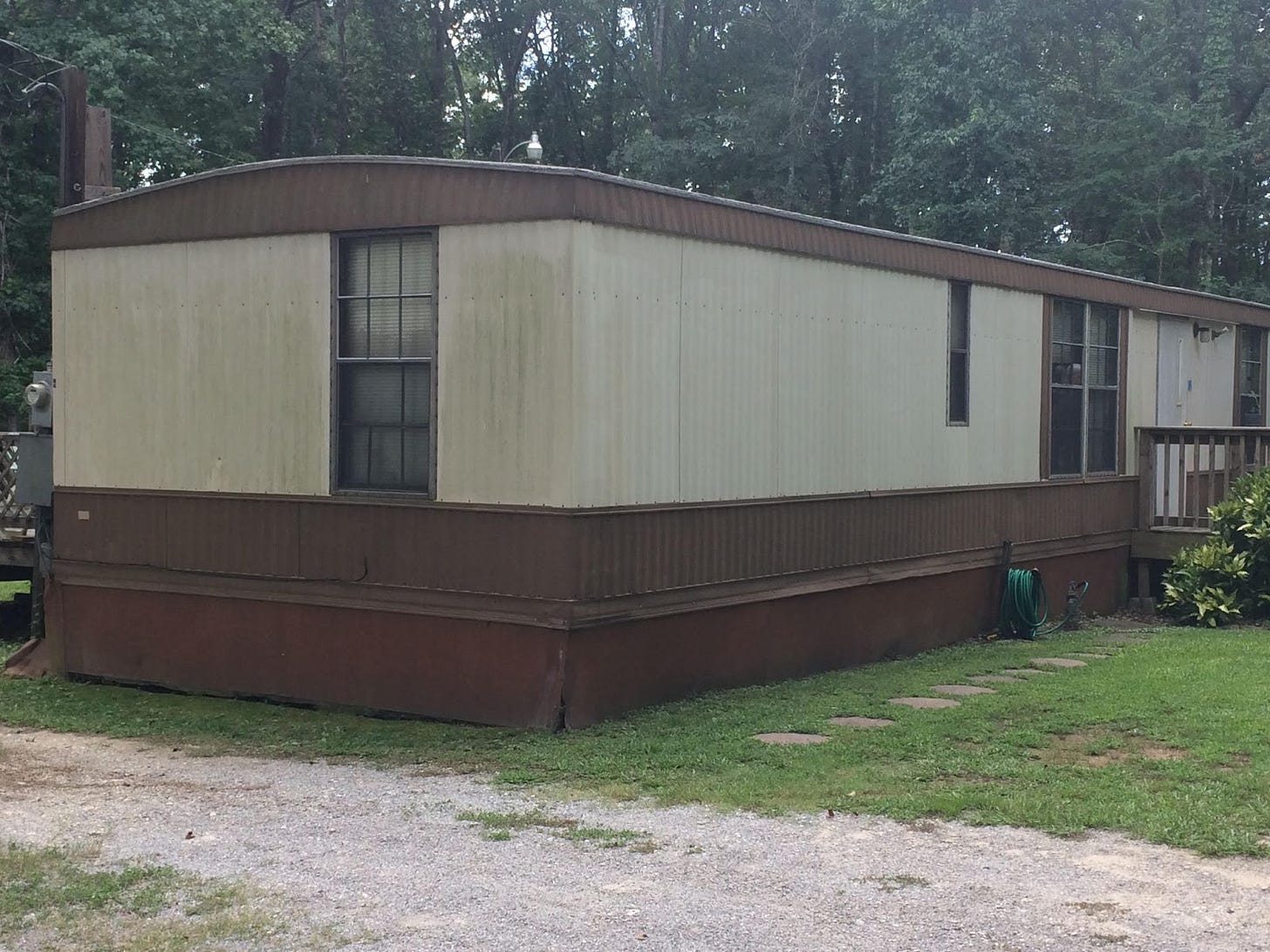The Dumbest Rule You’ve Never Heard Of
Whispers: "It's the Chassis Rule."
For understandable reasons, a lot of cost-of-living discourse is centered around just how expensive our priciest cities are, but many people who live in rural and exurban areas have affordability challenges too. These people’s particular adversities are quite personal for me because I’ve seen them up close. When I was growing up in Alabama, we lived in a mobile home (picture below) out in the country until I was in fifth grade.
Small manufactured homes (SMH), often colloquially called mobile homes or trailers (even though they are not meant to be moved or pulled behind a vehicle) are the lowest cost form of single-family homes. Though they are often left out of today’s housing discourse, SMHs are providing 8.4 million affordable homes in the United States. They help the rural working class save a lot of money. By one estimate, they can be up to 35% cheaper per square foot than traditional homes. And they can be especially helpful during periods (like now) when borrowing is more difficult and more costly. And, small manufactured homes today are a lot better than they used to be, thanks to significant code updates made by the Manufactured Housing Improvement Act of 2000 made significant code updates.
But there’s a problem that drives up the cost of these homes that most people don’t know about. I want to tell you about a rule that drives up housing costs for rural mobile homes residents: the Chassis Rule — the dumbest rule you’ve never heard of.
Where The Chassis Rule Came From and What It Does
During the Great Depression, itinerant Americans looking for work would affix some form of very basic shelter to a chassis and tow it behind a vehicle as they searched for work. However, local zoning laws often banned them since they lacked sanitation facilities. Unlike those trailers, later small manufactured homes were much higher quality and were not intended to be moved, but the National Builders Code, which was created in 1974 with significant lobbying from developers of stick-built homes, still requires small manufactured homes to have a permanent chassis (for those of you who skipped shop class in 8th grade, a chassis is the load-bearing base frame of a vehicle). So this rule forces SMHs to, in this one pointless but also cost-increasing way, to pretend to be mobile even though they aren’t meant to be.

The chassis requirement reinforces stigma, makes it easier for local zoning laws to exclude low-income and working class families, and harder for SMH to be financed. It justifies exclusionary zoning and treats homes as movable, even when they aren’t. That adds $5,000 to $10,000 per unit, a huge burden on rural and working-class families. Repealing it would cut costs and expand access.
Removing the chassis rule is a good place to start too because it is part of federal, rather than state and local, regulations. For Congress, the legislative fix is easy, requiring only that lawmakers strike “on a permanent chassis” from the definition of a manufactured home in the National Builders Code, and that HUD and the Manufactured Housing Consensus Committee revise their rules to accommodate off-chassis construction. This is important. Lots of other smart policy reforms -though they are worth doing- are in fact hard to implement. This one isn’t.
The Chassis Rule Needlessly Blocks Multistory Construction and Design Flexibility
The permanent chassis requirement forces manufacturers to design around an obsolete transportation framework rather than optimizing for affordability, quality, and the specific needs of rural families. The chassis rule constrains design flexibility by essentially limiting manufactured homes to single-story, rectangular configurations that can be transported on wheels. This prevents manufacturers from building the multi-story homes and flexible floor plans that many families want. Additionally, without chassis constraints, manufacturers could build two-story homes that provide more living space on smaller lots. This is particularly valuable in rural areas where families want yard space for children but face rising land costs. Moreover, recent federal rule changes now allow up to four manufactured housing units per structure, but only for chassis-free construction. Meaning that the chassis rule is forcing buyers of small manufactured homes to miss out on cost-saving multifamily options like duplexes.
Regulatory Details Matter for Real People
This is not a theoretical problem. Every month this stupid rule stays on the books, it's costing rural families thousands of dollars they don't have, for no reason other than regulatory inertia and the stick-built housing lobby's successful campaign for protectionism half a century ago. This isn’t just about cost though. With the chassis rule removed, builders of small manufactured homes will have a greater ability to aesthetically blur the line between manufactured housing and traditional housing —that’s a huge dignity boost for the working-class people who need/want to purchase a manufactured home.
Finally, removing the chassis is a terrific example of how deregulation can be progressive. These outdated regulations saddle working families with higher costs and fewer options. Striking "on a permanent chassis" from federal housing code is a simple fix that would unlock thousands of dollars in savings per home while enabling better designs and manufacturing innovations. Rural Americans deserve housing policies that work for them too. It's time for Democrats to champion practical reforms that deliver real relief to rural working-class families.
-GW




Of course the federal government would only have to remove the requirement, they would also shave to forbid states & municipalities from re-introducing or something equivalent. Without that, I suspect thousands of variations of the Chassis Rule will go into the effect the day after the federal rule is struck from the books.
Thanks for writing this!
1. Why was the chassis rule made in the first place? Even in the 1970s I'm pretty sure mobile homes were mostly parked and then done.
2. How do you transport these if you do away with the chassis rule?
I'm pretty new to this topic / ignorant but love the idea of eliminating a roadblock to innovation and affordability, just trying to understand the tradeoffs and initial reasoning.